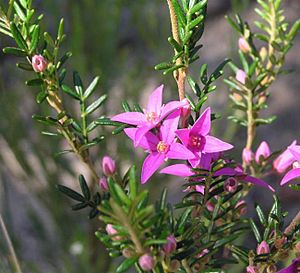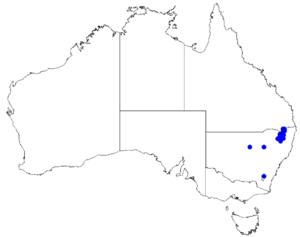Boronia granitica facts for kids
Quick facts for kids Boronia granitica |
|
|---|---|
 |
|
| Boronia granitica in Girraween National Park | |
| Conservation status | |
| Scientific classification | |
 |
|
| Occurrence data from Australasian Virtual Herbarium |
The Granite Boronia (Boronia granitica) is a special plant. It belongs to the citrus family, called Rutaceae. You can only find it in a small part of eastern Australia. This plant is a shrub that stands tall. It has many branches and leaves made of smaller parts. Its flowers are pink and have four petals.
Contents
What Does Granite Boronia Look Like?
The Granite Boronia is a shrub that grows upright. It can reach about 1.5 m (5 ft) tall. Its branches and leaves are covered in tiny, star-shaped hairs. These hairs can be white or reddish-brown.
The leaves are "compound," meaning each leaf is made of several smaller leaflets. There are usually seven to fifteen leaflets on each leaf. The whole leaf is about 8–20 mm (0.31–0.79 in) long and 2.5–15 mm (0.098–0.59 in) wide. The leaflet at the end is 1–11 mm (0.039–0.43 in) long. The side leaflets are 1–6 mm (0.039–0.24 in) long.
Its pretty pink flowers grow either alone or in groups of three. They appear where the leaves meet the stem, called the axil. Each flower sits on a short stalk, about 1–3 mm (0.039–0.12 in) long.
Each flower has four sepals. Sepals are like small leaves that protect the flower bud. These sepals are triangular and about 3.5–5 mm (0.1–0.2 in) long. They grow bigger as the fruit develops. The four petals are 6–9 mm (0.2–0.4 in) long and 3–4 mm (0.1–0.2 in) wide. They also get larger as the fruit grows.
Inside the flower, there are eight stamens. Stamens are the parts that produce pollen. They are different lengths. The flowers bloom from July to December. After flowering, the plant produces fruit. The fruit is about 4.5–7 mm (0.18–0.28 in) long and 2.5–3 mm (0.098–0.12 in) wide.
How Was It Named?
The Granite Boronia was first officially described in 1905. Two botanists, Joseph Maiden and Ernst Betche, gave it its scientific name. They wrote about it in a scientific paper called Proceedings of the Linnean Society of New South Wales. They studied a plant sample found growing in "the fissures of granite rock." This is why it's called "granitica."
Where Does Granite Boronia Live?
The Granite Boronia grows in open forests, woodlands, and heath areas. It prefers to grow in soil that comes from granite rocks. You can find this plant in a specific region of eastern Australia. It lives between Stanthorpe in Queensland and Armidale in New South Wales.
Why Is Granite Boronia Important?
The Granite Boronia is a very important plant because it is rare. The Australian Government lists it as "endangered." This means there are very few of these plants left in the wild. The New South Wales Government also lists it as "vulnerable."
Because it is endangered, a special plan has been created. This "recovery plan" aims to help protect the Granite Boronia. It helps scientists and conservationists work to increase its numbers. The goal is to make sure this unique plant can survive and thrive for many years to come.


